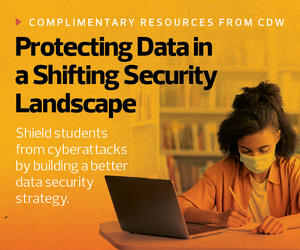A vCISO can offer guidance to improve the maturity and scope of a district’s cybersecurity model and advise school leaders on their organization’s security strategy and planning initiatives.
How Can vCISOs Help Districts Improve Their Security Strategies?
Virtual CISOs can help schools strengthen their cybersecurity posture in several ways. Bad actors are finding smarter and more advanced pathways to target school districts, but vCISOs have up-to-date knowledge of these constantly evolving threats.
With this information, vCISOs can strategically guide IT administrators and district leaders on what they need to do to fortify their networks and protect important data.
It’s important for school districts to mitigate their cybersecurity risks not only to protect student data but also to ensure they’re meeting necessary compliance requirements. Most ransomware and threat insurance providers require that schools meet a certain level of compliance when it comes to their security posture. If a school hasn’t updated a system or patched a vulnerability and then becomes the victim of an attack, the cyber insurance company won’t be able to help.
DIVE DEEPER: Grade your cybersecurity preparedness with this exclusive checklist.
Written premiums for stand-alone cyber coverage increased by 29 percent in 2020 as firms of all sizes clamored for insurance protection in the face of a substantial increase in network intrusions, data theft and ransomware incidents over the past two years. The broad shift to remote work at the start of the COVID-19 pandemic, coupled with increased intrusions from phishing emails, left all industries more exposed.
Districts also need to comply with the National Institute of Standards and Technology’s Cybersecurity Framework. NIST has a checklist and other resources on its website, and a vCISO can consult with schools to ensure they are in compliance.
Cybersecurity Is Important in Every Learning Environment
With the shift to remote learning, education saw a surge in cyberattacks and an increase in infamy for schools that were successfully targeted. Although many students are back in the classroom, now is not the time to relax cybersecurity protocols. Attacks are evolving to target K–12 institutions just as quickly as before, not to mention the malware students could be bringing onto a school network after operating outside of the traditional security parameters.
The threats can also be internal — curious students trying to bypass security barriers, for example. IT professionals in the schools need visibility into all of this activity so they can shut it down and keep their systems secure.







![[title]Connect IT: Bridging the Gap Between Education and Technology](http://www.edtechmagazine.com/k12/sites/default/files/articles/2014/05/connectit.jpg)




